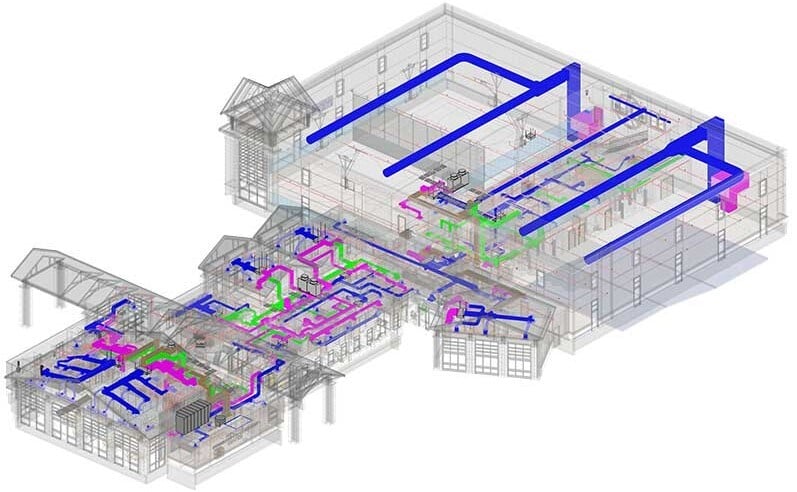.png)
Irfaan Mohamed is a BIM Implementation Specialist who completed their B.Tech in Civil Engineering from BSA Crescent Institute of Science and Technology. Currently working with UNEC, they have been involved in digital project management across metro, bridge, tunnel, hydropower, and high-rise building projects valued at up to $3B. Learn more about Irfaan’s work and connect with them on LinkedIn.
Even with growing BIM adoption across the AEC industry, many projects still fall short of expectations. The root cause often lies not in the software, but in unclear goals, poor collaboration, and limited training. These gaps create inconsistent workflows and data discrepancies, which in turn affect project outcomes. Achieving successful BIM implementation can be a challenge. It requires aligning people, processes, and technology under a clear strategy. BIM Standardised practices, transparent communication, and regular reviews are key to sustaining results. By learning from common mistakes and focusing on integration and accountability, organisations can unlock BIM’s real value — improved BIM coordination, cost savings, and predictable delivery.
Common Reasons Why BIM Projects Fail
One of the biggest reasons many BIM projects fail and how to fix them can be avoided by better BIM execution planning. Teams often jump straight into modeling without even having a proper BIM kickoff meeting. When that happens, no one really takes ownership of deliverables, and roles remain unclear. Each team assumes someone else is driving the process. Eventually, BIM coordination gaps appear, deadlines slip, and the project loses momentum.
A well-structured BIM kickoff isn’t just a formality, it’s the foundation for success. It sets expectations, assigns clear responsibilities, and aligns everyone on the same digital strategy from day one. These are some of the BIM roles and responsibilities to follow for project success.
Identifying Potential Risks Early On
Most risks in BIM projects arise because teams do not identify them early enough. The best way is to start with a proper review before even touching the model, check the team’s capability, software versions, templates, and standards. Many times, teams just assume everyone is on the same page, but later realise they’re not even working in the same environment.
Doing an early BIM capability check and regular coordination reviews really helps. It’s better to identify those gaps in the beginning rather than after the model is halfway done. A few simple steps like this can save a lot of rework and frustration later
Importance of Collaboration and Communication
Poor communication is one of the biggest reasons BIM projects go off track. In many cases, where design teams, contractors, and consultants work in silos, everyone is doing their own part, but no one is actually syncing up. When that happens, models start to drift apart, clashes repeat, and even small coordination issues take forever to resolve.
What makes it worse is when the BIM modeller or model producer doesn’t fully understand what’s happening on-site, while the BIM Manager or site team knows the real ground conditions, but that information never reaches the modeling team. This disconnect leads to inaccurate models, wrong assumptions, and unnecessary rework.
BIM is meant to bring everyone together under one source of truth, but when communication fails, that purpose is lost. It’s not about having multiple software or dashboards; it’s about ensuring everyone actually talks to each other and shares updates in time.
Also Read: 6 BIM Certifications You Can Get for Career Advancement
Strategies That Ensure Smooth Collaboration Across Disciplines
For smooth collaboration, teams need both the right process and the right mindset. Start with a proper communication and BIM execution plan. Common BIM execution plan mistakes and remedies define how information will be shared, who will update what, and how frequently coordination meetings will happen.
Having a common platform like ACC, Trimble Connect, or any CDE definitely helps, but only if teams use them actively. Regular model reviews and transparent issue tracking are key. When each discipline understands how their work affects others, for example, how a small modeling change can impact site sequencing or cost, collaboration naturally improves.
In the end, BIM collaboration isn’t about tools alone, it’s about making sure every team member, from modeller to manager, is aligned and accountable.
Technical Pitfalls and Software Misuse
Many BIM projects face problems due to poor technical setup. Most models are segregated incorrectly, separate BIM files for each level or discipline, which makes BIM coordination and integration very difficult. Often, folder and sharing structures aren’t set up according to ISO standards, so teams struggle to find the right files.
Misusing BIM tools as just 3D drafting software also causes issues. A proper BIM setup, clear model segregation, folder hierarchy, and naming rules, saves a lot of rework and keeps collaboration smooth.
Avoiding Errors Related to Software and Standards
Teams can avoid most technical errors by setting up BIM standards and workflows from the start. Use consistent templates, shared family libraries, and a clear naming and folder structure based on ISO guidelines. Regular model audits and coordination checks ensure everyone follows the same rules.
The key is consistency, when everyone works in the same environment with clear standards, errors drop, coordination improves, and the BIM model becomes reliable for downstream use.
Best Practices to Ensure BIM Project Success
The most effective way to prevent BIM failures is to focus on BIM execution planning, ownership, and communication from the start. First, conduct a proper BIM kickoff meeting to define roles, responsibilities, workflows, and deliverables, this ensures everyone knows what they are accountable for.
Second, standardize templates, file structures, and modeling practices so all teams work in the same environment. This avoids errors, data loss, and coordination issues later.
Third, maintain regular BIM coordination and quality checks. BIM clash detection, model audits, and clear issue tracking help catch problems early.
Finally, invest in training and monitoring. When teams understand the tools, standards, and collaboration process, and someone is actively monitoring progress, most common BIM failures can be avoided. These are some of the best practices for clash detection and resolution in BIM.
Also Read: 5 Best Urban Design Firms in India To Work With
Implementing These Practices in Small and Large Projects
For small projects, the key is to keep things simple but structured. Even if the team is small, they should start with a short BIM kickoff meeting, agree on a single template, and follow a basic folder and naming structure. One person can take ownership of coordination and model checks, that alone brings a lot of clarity.
For large projects, it’s about scaling those same principles. Have a dedicated BIM coordinator or manager for each discipline, define clear workflows in the BEP, and conduct regular model reviews. Use CDE platforms like BIM 360 or Bexel CDE for collaboration and issue tracking.
The approach doesn’t change, only the scale does. Whether it’s a small building or a large infrastructure project, clear setup, consistent BIM standards, and continuous coordination are what make BIM actually work.
Conclusion
BIM success isn’t about tools, it’s about people, processes, and planning. Clear roles, structured workflows, and consistent standards prevent confusion and errors. Early risk checks, regular BIM coordination, and ongoing quality control ensure models stay reliable and useful. Training teams and fostering transparent communication keep everyone aligned, whether the project is small or large. When these principles are followed, BIM becomes a powerful tool for collaboration, efficiency, and informed decision-making, rather than just a 3D model.
For those considering the upskilling route, Novatr’s BIM Course for Architects offers a solid starting point, providing in-depth exposure to BIM workflows, tools, and computational design processes aligned with industry expectations.
Was this content helpful to you







